Sidewalks
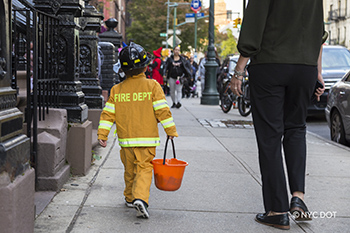
- Maintenance
- Inspections & Violations
- Repair
- Dismissal Inspections
- Contesting a Sidewalk Violation
- Other Sidewalk Questions
New York City has over 12,000 miles of sidewalks. Smooth, even sidewalks free of defects and debris provide a safe place for New Yorkers to walk, use a wheelchair, or push a stroller or shopping cart. NYC DOT is committed to making our pedestrian space safe and accessible for all.
Maintenance
NYC DOT's goal is to make the City's sidewalks safe for pedestrians and help prevent injuries caused by defective sidewalks. The City replaces more than two million square feet of sidewalk a year, mostly on City-owned property and in residential neighborhoods with predominately one, two and three family homes.
Sidewalks should be free of cracks or holes and have an even surface. NYC relies on property owners to maintain the sidewalk adjacent to their property, including repairs and removal of snow, ice, or debris.
Property owners are responsible for installing, repairing and maintaining sidewalks adjoining their properties (Section 19-152 of New York City's Administrative Code).
Property owners are potentially liable for personal injuries caused by their failure to maintain the sidewalk free of defects (Section 7-210 of the New York City’s Administrative Code). We encourage property owners to perform repairs to their sidewalk before a condition becomes a defect which may result in a Notice of Sidewalk Violation.
Common Sidewalk Defects
Sidewalk defects that can be cited with violations are listed in section 19-152 of the New York City Administrative Code.
Some of the common defects that could result in a violation:
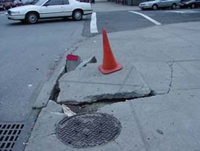
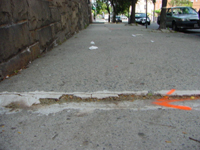
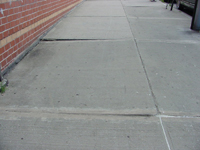
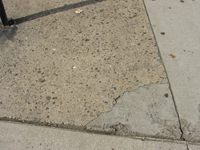
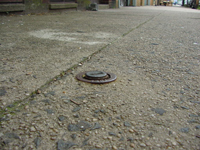
Problems Caused by Tree Roots
If sidewalk problems are caused by tree roots, the property may be eligible for repair by the Department of Parks and Recreation (DPR) under their Trees and Sidewalks program. DPR also offers free consultations for property owners doing work around tree roots. Cutting or shaving the roots of City-owned trees is strictly prohibited.
NYC does not charge owners of one, two or three family properties for the repair of a sidewalk damaged by a City tree or tree roots.
Remove a Lien Due to City Tree Damage
The City will no longer issue a sidewalk violation for one, two and three family properties that have sidewalk damage caused solely by City trees.
NYC DOT has completed the review of all outstanding Notices of Sidewalk Violation for one, two and three family properties and determined which were caused solely by City street trees and will cancel the lien for any that meet the criteria.
Missing or Defective Curbs
Property owners are encouraged to repair or replace missing or defective curbs. NYC DOT may repair or replace missing and defective curbs at no cost to the property owner when performing sidewalk work related to a violation or when there is an active Curb Repair Contract.
Problems Caused by Others
If a sidewalk was damaged by a utility company or other contractor, the property owner must document the damage and reach out to the company who made the damage for repair. Search permits that NYC DOT has issued for an address or area. Claims against utility companies should be filed with their respective claims departments.
Inspections
NYC DOT inspects sidewalks throughout the city to ensure that they are safe. If inspectors find an unsafe sidewalk condition, a Notice of Sidewalk Violation will be issued to the property owner.
Notices of Sidewalk Violation
A sidewalk violation is an official notice issued by NYC DOT to a property owner, stating that the sidewalk is defective.
The City issues sidewalk violations to encourage property owners to repair their sidewalks to enhance public safety. There is no fine associated with a violation. A copy of the notice is filed with the County Clerk and remains on file until the Clerk receives official notification from the City that satisfactory repairs have been made. A violation may complicate selling or refinancing a property. Request the status or a copy of a sidewalk violation via NYC311
A property owner has 75 days to make a repair after a Notice of Sidewalk Violation has been received. If a property owner does not perform repairs within 75 days, NYC DOT may have a contractor perform the work, and the Department of Finance will bill the property owner pursuant to Section 19-152 of the New York City Administrative Code.
If a property owner received multiple Notices of Sidewalk Violation, the newest violation supersedes all previous notices. Every flag (sidewalk square) marked with a number on the Preliminary Inspection Report (the sketch included with the violation) must be replaced and any defects must be corrected.
Counting the 75 Days
The 75 days begins when the Notice of Sidewalk Violation is received by the property owner as indicated on the certified mail receipt. When the notice is not delivered by mail, the sidewalk violation will be posted on the property, and the posting date is the start of the 75 days.
The 75 day period is the same throughout the year. A contractor should be scheduled to perform the repairs as weather permits.
Repair
To repair a sidewalk, a property owner should:- NYC Sidewalks: A Property Owner’s Guide to Address Sidewalk Defects (pdf)
- Download a checklist for repairing a sidewalk (pdf)
- Hire a licensed contractor
- Obtain necessary permits
- Review Guidelines for the Design of Sidewalks (pdf) and Commercial District Sidewalk Design Standards
- Request a dismissal inspection when repairs are completed
Picking a Contractor
Hire a contractor who is familiar with NYC DOT specifications for sidewalk repair. Start by searching the Department of Consumer Affairs’ (DCA) database of licensed contractors, to find a contractor or verify that the contractor is licensed.
Once a contractor has been selected, you may contact NYC311 to find out if there are any consumer complaints pending against them. DCA’s Quick Tips on Hiring Home Improvement Contractors DCA’s Consumer Guide to Home Improvement (pdf)
Sidewalk Construction Permits
Before sidewalk repairs begin, be sure that the property owner and/or contractor has all necessary permits and information. Note: a sidewalk permit does not extend the 75 day period to start repairs.
Currently, the price of a sidewalk repair permit is $70 for every 300 linear feet of sidewalk for any one property. Multiple permits may be needed if work will be performed at a corner property or through lot. Sidewalk Construction Permit via nycstreets.net The Rules of the City of New York – Chapter 2: Highway Rules DDC’s Standard Details of Construction (pdf) NYC DOT Instructions for Filing Plans & Guidelines for the Design of Sidewalks (pdf)
Commercial District Pigmented Concrete Sidewalk Standards
NYC has a standard for pigmenting and scoring sidewalks to encourage an attractive, uniform appearance in the city’s busiest commercial areas (Chapter 2 § 2-09(f)(4) of the Highway Rules). Learn more about pigmented concrete in the Street Design Manual
Pigmented Sidewalk Rules Apply in Certain Commercial Districts
Pigmented concrete material must be used on sidewalks in front of all lots in commercial zoning districts C4-4 through C4-7, C5 and C6. This includes special purpose districts where such zoning is the underlying control, such as the Special Midtown District. Search NYC zoning maps by address, intersection or tax block and lot
Existing sidewalks in these commercial districts do not need to be replaced to meet the standard. These may remain as they are, unless replacement of more than 50 percent of the sidewalk in front of a lot is planned, then pigmented concrete must be used. Property owners may choose to use the pigmented concrete standard if replacing less than 50 percent of their sidewalk.
The standard does not apply to landmarked historic districts.
Public Design Commission (PDC) approval
Public Design Commission (PDC) approval is not required if the pigmented concrete is being used in the prescribed commercial districts (C4-4 to C4-7, C5 and C6). Outside of those districts it is considered distinctive and requires a Distinctive Sidewalk Maintenance Agreement with NYC DOT and PDC approval.
Properties within these commercial districts may still apply for distinctive sidewalks if they so choose, though this is discouraged by NYC DOT and PDC.
Distinctive Sidewalks
If you currently have a material other than standard concrete or wish to propose a material other than standard concrete for the sidewalk in front of your property, there are additional reviews required before you may begin construction or repair work. For properties with an existing concrete sidewalk, refer to the standard sidewalk material process (pdf) More information about sidewalk materials in the Street Design Manual
Vaults
A vault could include basement space for a building, under a sidewalk. Fixing the sidewalk over a vault may require considerable structural work. If the defective portion of the sidewalk is over a vault, the property owner must repair the sidewalk privately. The City will not repair sidewalks over vaults or other structures.
NYC DOT's Expedited Sidewalk Repair Program
The Expedited Sidewalk Repair Program is on pause until further notice.
Repairs Performed by NYC DOT
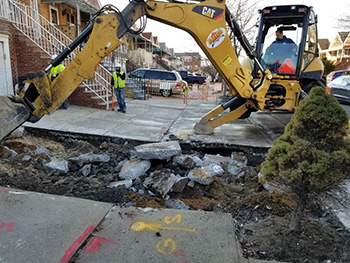
If sidewalk defects are not repaired within 75 days after a Notice of Sidewalk Violation is issued, NYC DOT may perform the sidewalk repair or hire a contractor to perform the work.
The property owner will receive a formal notification before the City's contractor arrives to perform the work. A consultant or representative of the City will photograph the sidewalk to document the condition before construction, mark the sidewalk flags that must be replaced, and then perform the necessary repair work.
After all defects have been repaired, the property owner will receive a bill from the Department of Finance and NYC DOT will notify the County Clerk’s Office to remove the violation from their records.
Cost of NYC DOT Sidewalk Repairs
To estimate the cost of the repair, multiply the estimated square footage shown on the Preliminary Inspection Report (PIR) by the cost per square foot shown on the letter (concrete cost is subject to change) that came with the Notice of Sidewalk Violation. If any of the area to be repaired is a driveway, use the seven inch (7”) concrete cost for that area, otherwise use the cost of four inch (4”) concrete. The final bill may reflect additional repairs required to remove all defective conditions.
If any sidewalk flag on the PIR (sketch) is marked with an "X", NYC DOT may replace the sidewalk flag at no charge to the property owner. A final decision regarding the replacement of such flag will be made by a Department of Design and Construction (DDC) engineer at the time of construction.
The property owner has 90 days to pay the bill before interest is added. After 90 days, interest will accrue and a monetary lien will be placed against the property. The contractor's work is guaranteed for 18 months from the end of the contract period.
To request a payment plan for a sidewalk repair by the City, visit a Department of Finance Business Center or contact NYC311 and select Sidewalk Repair Payment Plan.
Contesting Work Done by the City
If the City performs sidewalk repairs and the property owner is not satisfied with the quality of the work, the amount of work that was done, or the accuracy of the measurements used to calculate the bill, the property owner should make an appeal to the Department of Design and Construction (DDC).
- Contact a DDC Borough Office via NYC311 or DDC’s website. Telephone calls and personal visits will not be considered appeals.
- If a property owner is not satisfied with DDC’s response, file a Notice of Claim with the Office of the Comptroller.
- If the Comptroller's Office does not find in the property owner’s favor, the property owner may file a Petition of Appeal at the New York State Supreme Court, Small Claims Assessment Review Part. The petition forms are provided upon request, at no cost, by the County Clerk's office. To be eligible, the property owner must allege that at least 30 days have passed since the Notice of Claim was presented to the Office of the Comptroller and that they did not make a determination or denied the claim.
*Important: All of the above procedures must be followed in the exact order outlined above.
If the City contractor damages a sidewalk through its own negligence, the contractor must make the repairs at no cost. Please contact the DDC Borough Office or contact NYC311 and select DDC Services and Projects.
Claims for damage allegedly done by the City should be filed with the Office of the Comptroller within 90 days of the damage. Contact NYC311 for more information about How to File a Claim Against the City.
Dismissal Inspections
Once the sidewalk repairs are done, contact NYC311 to request a Sidewalk Violation Dismissal Inspection.
Have all of the following information ready:
- Permit number
- Property address
- Block and lot number
- Violation number
- Email address and phone number of the property owner
NYC DOT will send an inspector to verify that the work has been satisfactorily completed. Make sure that the entire sidewalk is visible before the inspection.
Contesting a Sidewalk Violation
Request a Re-Inspection
If the sidewalk defect on the Notice of Sidewalk Violation does not match the sidewalk condition, a property owner may request a re-inspection within 75 days of receiving the notice.
Property owners should review the Preliminary Inspection Report (PIR) to check the width and other dimensions of the property. Check the location of trees, signs, utility caps, cellar doors, or other features. If the property details do not match the PIR, contact NYC311 to Appeal a Sidewalk Violation. NYC DOT will review the request and schedule a re-inspection within 180 days of the appeal.
A re-inspection is a second inspection of the sidewalk by a different inspector who does not have access to the report made by the first inspector. A property owner will be notified by mail at least five days before the re-inspection date. Inspectors will not come to the door, as they are prohibited from seeking out property owners when conducting re-inspections. This is the final inspection. The results of the re-inspection will be sent to the property owner.
Note: If the violation was issued to the incorrect property owner, please contact NYC311 to Appeal a Violation.
Other Sidewalk Questions
For other questions about sidewalks in New York City, or to share comments on the services of NYC DOT's sidewalk inspectors or private contractors, please contact NYC DOT online, NYC311, or mail a letter to:
Sidewalk Program
NYC Department of Transportation
55 Water Street, 12th Floor
New York, NY 10041
